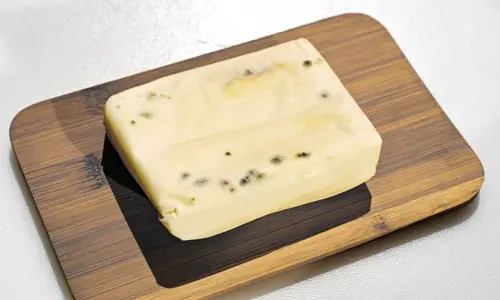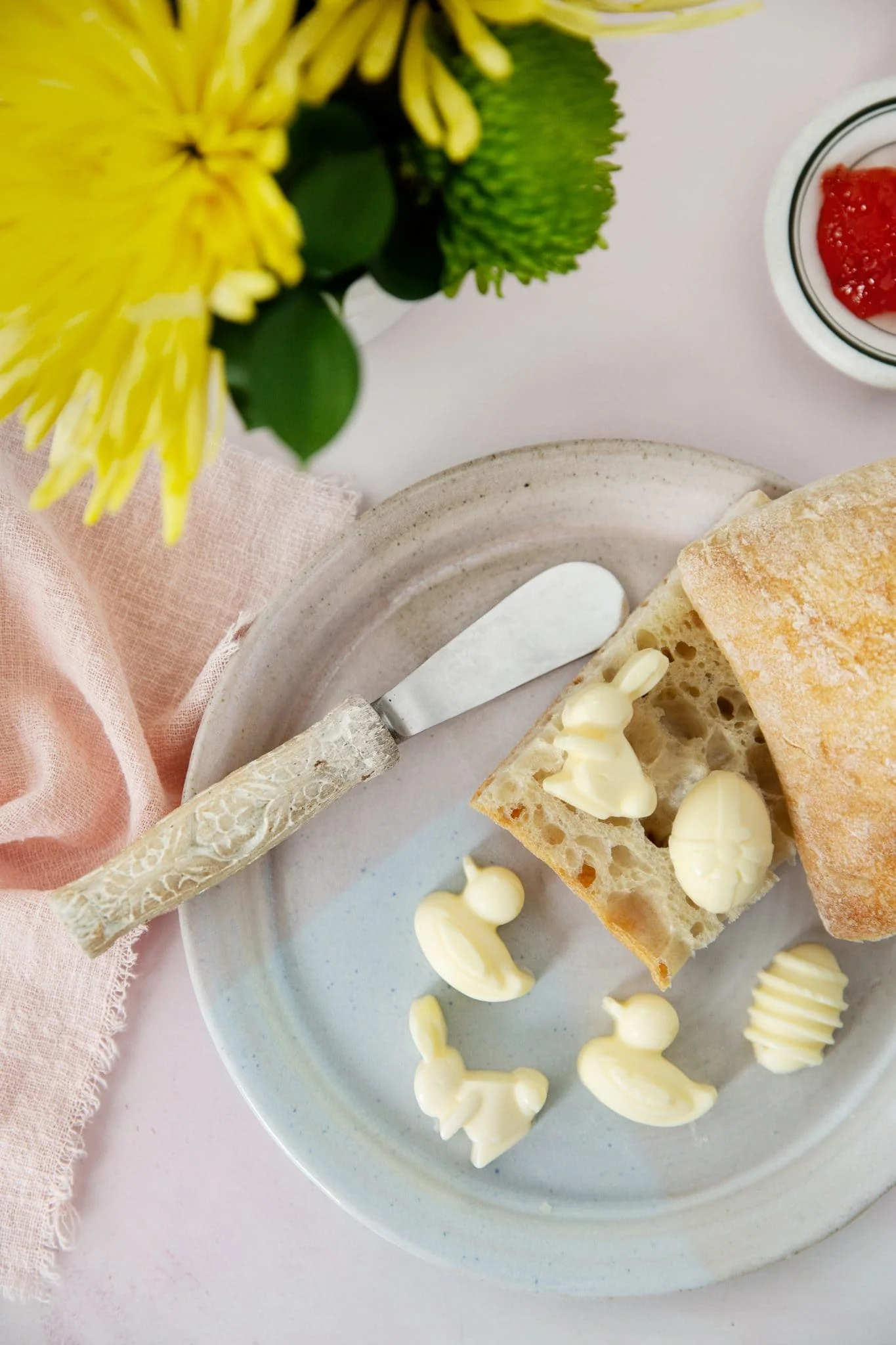Has your butter just grown a peculiar area of fuzz that has you saying “hmm”? Not to worry, we’ll get into the deep gritty of what causes butter to mold, what it looks like, how to prevent and control it, and more. By the end, you’ll be a true butter expert!

What Causes Butter To Grow Mold?
Warmth and air exposure are the two most common causes of mold formation in butter. Butter contains approximately 80% milk fat, which provides a great environment for mold spores to grow in given the correct conditions. Molds are naturally present all around us in the form of microscopic, invisible spores, just waiting for somewhere humid to set up business.
When butter is left unrefrigerated or is regularly taken in and out of the refrigerator, those sly spores have a warm location to take root. The fat and moisture provide them with everything they require to grow into the fuzzy spots we call mold.
What Does Moldy Butter Look Like?
Mold commonly appears as fuzzy or discolored areas on the surface of the butter. Depending on the fungal type, common molds that infect butter appear fluffy and vary in hues of blue, gray, green, or black. Colonies in the early stages may seem as weak white or blue specks, but as the mold matures, these areas will become more noticeable, textured clusters.
Mold strands frequently have distinct root-like growths called mycelium running beneath the butter surface. If you cut into moldy butter, you’ll notice that the webs of this fuzzy filament structure have infiltrated what was previously smooth butter. As the fungi feast and generate metabolic byproducts, the moldy areas may have an unpleasant, ruined odor.
How Do You Know if Butter Has Gone Bad?
A few signs that butter has potentially gone off include:
- Visible molds as previously mentioned
- a rancid odor (a sour or chemical odor)
- Color shift (yellowing, spots)
- Instead of solid shape, use a soft, greasy, or moist texture.
- The expiration date is stamped on the box.
- Any apparent molds, yeasts, or bacteria growth
While it’s not an exact science, your nose and eyes are usually good judges of butter that has passed its prime. When in doubt, toss it! Stale or moldy butter should be discarded for freshness and food safety.

How Long Does It Take Butter To Grow Mold?
Exact mold incubation times vary depending on temperature, but most experts believe that butter left at room temperature (about 20-25°C or 68-77°F) will show obvious mold growth in 5-10 days. Refrigerated butter kept at 3-4°C (35-40°F) can be stored for several weeks before mold appears.
Cooler temperatures decrease the metabolism of molds and bacteria, thereby halting their growth. Warmer locations, such as countertops, give perfect growing conditions, causing molds to proliferate significantly faster in just a few days. Proper cooling in the fridge is essential for extending the shelf life of butter before molds form.
Is Moldy Butter Safe to Use?
- Dangerous molds such as penicillium, aspergillus, and fusarium can live in butter.
- Mold mycotoxins can cause disease if swallowed.
- Mold may penetrate deep into butter, not only on the surface.
- Scraping off mold leaves microscopic mold tendrils behind.
- Even little mold patches suggest that the quality and safety of the butter has been affected.
Can I Cut Off the Moldy Part and Eat the Rest?
Mold spreads swiftly through soft, porous foods like butter, reaching deeper than you can see. Cutting off the obvious moldy area does not mean the rest is safe to consume.
Mold, a form of fungus, spreads far beyond what is visible to the naked eye. It propagates microscopic roots, or hyphae, far into the food it enslaves. Because butter is so wet and heavy in fat, it creates the perfect environment for mold to develop.
On top of that, even after removing the moldy part, some people still have severe allergies to mold. That’s why you should never eat moldy butter because it can make you very sick, even giving you food poisoning.
How To Prevent Butter From Going Moldy?
To avoid mold in butter, focus on proper refrigeration and storage methods:
- Store butter in an airtight container or tightly wrapped in plastic wrap or foil.
- Keep butter in the refrigerator’s main body between 3-5°C and 35-40°F.
- Use a butter dish if the lid can be securely closed after each use.
- Do not leave butter out after it has been refrigerated for an extended period of time.
- Use a butter keeper or other ventilated butter dish.
- To avoid spoilage, consume butter within the stated use-by date.
Implementing these fundamental butter handling guidelines will ensure that your golden spread is mold-free for optimal freshness and enjoyment!
How Do You Store Butter at Room Temperature?
If you prefer softened butter at room temperature for cooking or spreading, only leave out the amount you’ll need that day and promptly return the unused piece to the fridge. Mold can be prevented by using airtight containers with tight-sealing lids. Using a thin butter bell container designed for room temperature butter storage circulates air and reduces moisture buildup, both of which mold loves.

Can I Bake With Moldy Butter?
While some molds are not technically harmful, they can have an adverse effect on taste and texture while baking. It is preferable to avoid using rotten butter in dishes that are intended to be ingested. If a small area has formed, you may be able to remove a thin layer surrounding and beneath the mold location.
The high heat of the oven should kill any mold or germs in baked items. But, in my opinion, it’s not worth the risk of unknown mold toxins for a small amount of butter savings. I’d recommend cutting your losses, throwing out the rotten butter, and beginning over with a new stick. Your baked goods and your family’s health are worth the modest extra cost.
What Happens If You Eat Moldy Butter?
Mold growth, in general, indicates that the butter has passed its peak quality and freshness and should be discarded. Some molds create mycotoxins, which, if consumed, can induce allergic reactions or gastrointestinal disorders such as nausea, stomach cramps, or diarrhea, especially in young children, the elderly, or individuals with compromised immunity.
While butter molds are usually not the most dangerous, swallowing anything visibly moldy is like playing nutritional roulette. To reduce the risk of food-borne illness for you and your loved ones, use the “when in doubt, throw it out” rule of thumb. It’s not worth risking your health for a glob of flavorless mold butter!
Conclusion
Understanding mold formation in butter and mastering preventative methods will help you keep your butter balm fresh and breezy. Don’t let the appearance of those furry intruders deter you from enjoying your butter straight from the fridge again. With some simple care, both you and your butter can have a long and healthy life free of mold. It’s time to cover up without fear!
FAQs
Throwing it out is the safest bet. Eating any form of microbiological organism is not safe. There is an extremely high risk of food poisoning if you eat the butter. The safest option would be to throw it out!
Keep the right type on the counter. Unsalted butter is fine at room temperature, but salted butter is better. In fact, salted butter can sit out on the countertop for a longer period of time without spoiling since salt is a natural preservative, Bell explains. That means the salt protects against bacterial growth.
The pink stain is usually due to native and contaminated microflora composed of bacteria and yeasts. Aureobasidium and Fusarium are the most common types of fungi that people often call “pink mold”, but there are several bacteria species that have a pink color when growing; in most cases, it is Micrococcus roseus.
Although butter is not a highly perishable food, it does undergo spoilage by bacteria and molds. The main source of microorganisms in butter is cream, whether sweet or sour, raw or pasteurized.
Eating any form of microbiological organism is not safe. There is an extremely high risk of food poisoning if you eat the butter. The safest option would be to throw it out!
Although you should look for mold, you’re more likely to see subtle signs of spoilage like changes in color or texture and off smells. And although spoiled butter probably won’t make you sick, it certainly won’t taste good. If your butter smells or tastes sour or rancid, it’s time to toss it.
Sources:
- Is it safe to eat butter that have mold on the surface?
- Microbiological quality and safety of cooking butter in Beni-Suef governorate-Egypt
- The Colors Of Food Mold – Florida Mold Inspector
- Mold On Butter: Is It Safe To Use Moldy Butter & Can It Be Saved?
- How to Make & Mold Fresh Butter
- Mold on Butter – What’s the Cause and What to Do
- Does Butter Get Moldy?
- Does Butter Get Moldy? [And What To Do If That Happens]
- Mold on butter – is it safe to eat? what you should know
- Mold on Butter – Is it Safe to Eat?
- Butter as a Substrate for Mold Growth